UK Retail Food Waste Reduction: An Annotated Bibliography Approach
VerifiedAdded on 2023/06/12
|5
|1386
|266
Annotated Bibliography
AI Summary
This assignment is an annotated bibliography focusing on strategies for reducing food waste in the UK retail sector. It analyzes five key sources, including articles from The Guardian, Harvard Business Review, and parliamentary reports, alongside academic journal papers. The analysis covers topics such as supermarket pressures to cut food waste, the role of charities, retailer strategies, and government commitments. The bibliography also touches on social media analysis, identifying key influencers and hashtags related to climate change. The student also addresses the role of inventory management, supply chain partnerships, and consumer engagement in waste reduction. The document concludes with a social media analysis, listing top influencers and hashtags related to climate change, highlighting the interconnectedness of environmental issues and retail practices. The completed assignment is available on Desklib, a platform offering a variety of study resources for students.
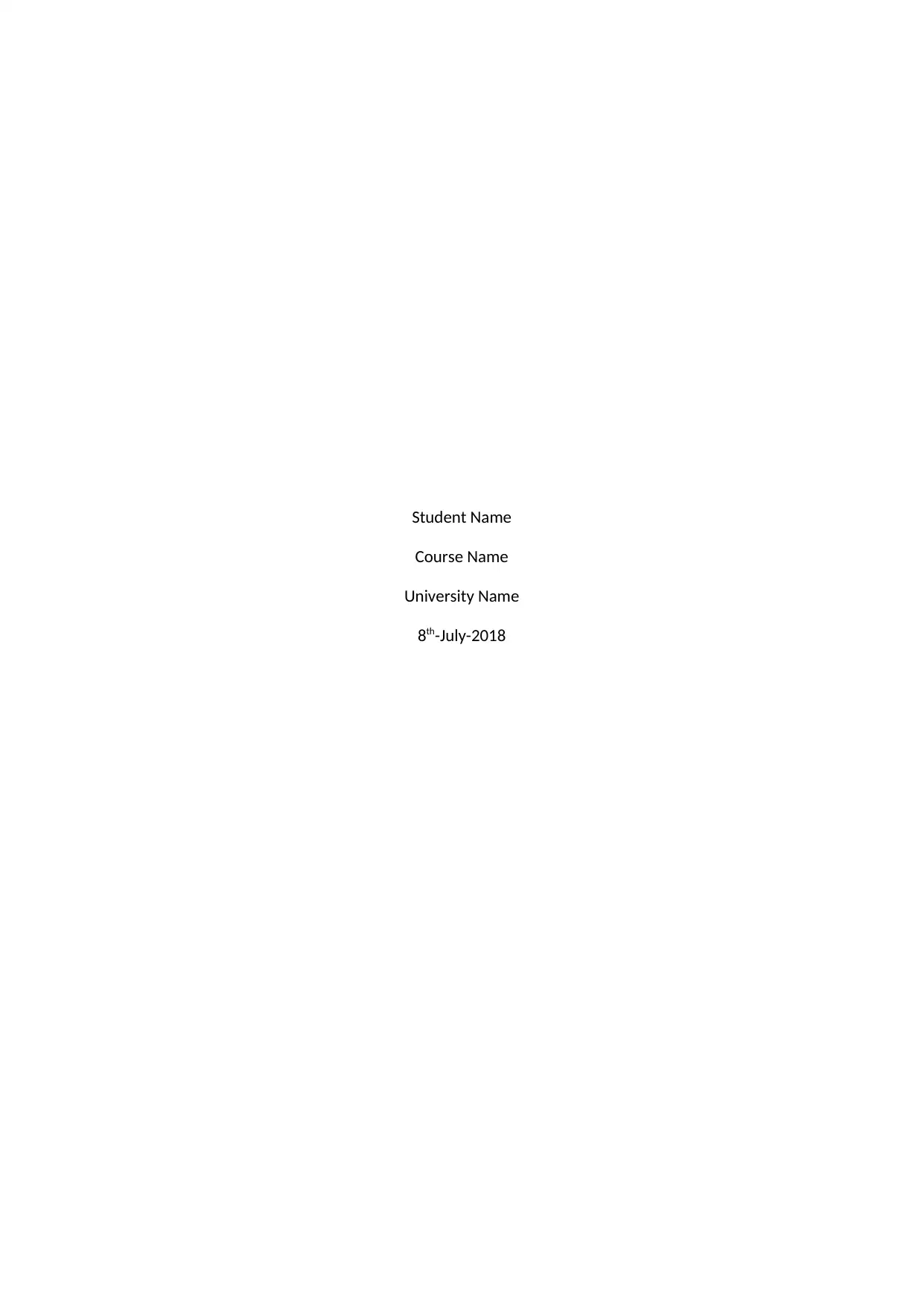
Student Name
Course Name
University Name
8th-July-2018
Course Name
University Name
8th-July-2018
Paraphrase This Document
Need a fresh take? Get an instant paraphrase of this document with our AI Paraphraser
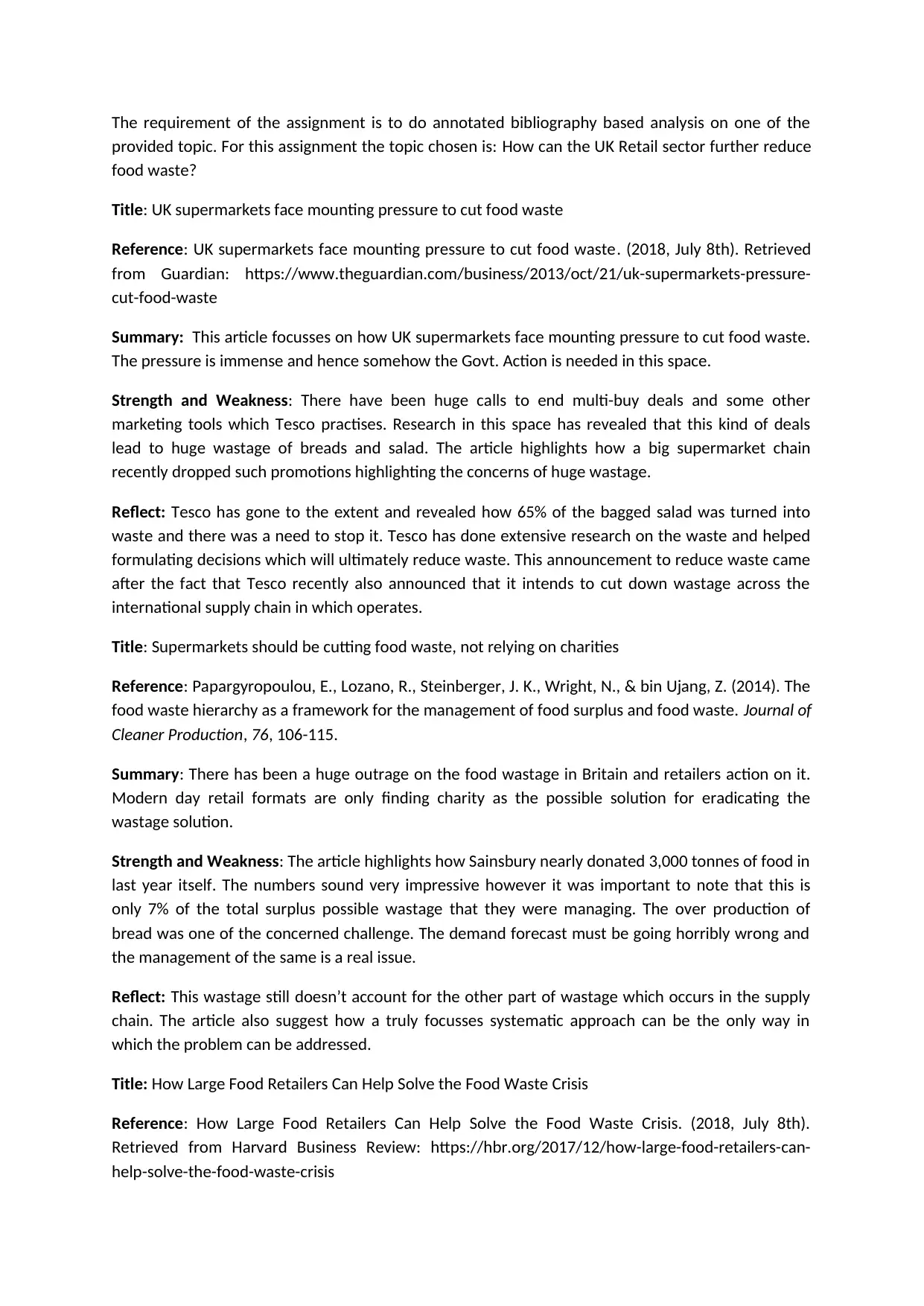
The requirement of the assignment is to do annotated bibliography based analysis on one of the
provided topic. For this assignment the topic chosen is: How can the UK Retail sector further reduce
food waste?
Title: UK supermarkets face mounting pressure to cut food waste
Reference: UK supermarkets face mounting pressure to cut food waste. (2018, July 8th). Retrieved
from Guardian: https://www.theguardian.com/business/2013/oct/21/uk-supermarkets-pressure-
cut-food-waste
Summary: This article focusses on how UK supermarkets face mounting pressure to cut food waste.
The pressure is immense and hence somehow the Govt. Action is needed in this space.
Strength and Weakness: There have been huge calls to end multi-buy deals and some other
marketing tools which Tesco practises. Research in this space has revealed that this kind of deals
lead to huge wastage of breads and salad. The article highlights how a big supermarket chain
recently dropped such promotions highlighting the concerns of huge wastage.
Reflect: Tesco has gone to the extent and revealed how 65% of the bagged salad was turned into
waste and there was a need to stop it. Tesco has done extensive research on the waste and helped
formulating decisions which will ultimately reduce waste. This announcement to reduce waste came
after the fact that Tesco recently also announced that it intends to cut down wastage across the
international supply chain in which operates.
Title: Supermarkets should be cutting food waste, not relying on charities
Reference: Papargyropoulou, E., Lozano, R., Steinberger, J. K., Wright, N., & bin Ujang, Z. (2014). The
food waste hierarchy as a framework for the management of food surplus and food waste. Journal of
Cleaner Production, 76, 106-115.
Summary: There has been a huge outrage on the food wastage in Britain and retailers action on it.
Modern day retail formats are only finding charity as the possible solution for eradicating the
wastage solution.
Strength and Weakness: The article highlights how Sainsbury nearly donated 3,000 tonnes of food in
last year itself. The numbers sound very impressive however it was important to note that this is
only 7% of the total surplus possible wastage that they were managing. The over production of
bread was one of the concerned challenge. The demand forecast must be going horribly wrong and
the management of the same is a real issue.
Reflect: This wastage still doesn’t account for the other part of wastage which occurs in the supply
chain. The article also suggest how a truly focusses systematic approach can be the only way in
which the problem can be addressed.
Title: How Large Food Retailers Can Help Solve the Food Waste Crisis
Reference: How Large Food Retailers Can Help Solve the Food Waste Crisis. (2018, July 8th).
Retrieved from Harvard Business Review: https://hbr.org/2017/12/how-large-food-retailers-can-
help-solve-the-food-waste-crisis
provided topic. For this assignment the topic chosen is: How can the UK Retail sector further reduce
food waste?
Title: UK supermarkets face mounting pressure to cut food waste
Reference: UK supermarkets face mounting pressure to cut food waste. (2018, July 8th). Retrieved
from Guardian: https://www.theguardian.com/business/2013/oct/21/uk-supermarkets-pressure-
cut-food-waste
Summary: This article focusses on how UK supermarkets face mounting pressure to cut food waste.
The pressure is immense and hence somehow the Govt. Action is needed in this space.
Strength and Weakness: There have been huge calls to end multi-buy deals and some other
marketing tools which Tesco practises. Research in this space has revealed that this kind of deals
lead to huge wastage of breads and salad. The article highlights how a big supermarket chain
recently dropped such promotions highlighting the concerns of huge wastage.
Reflect: Tesco has gone to the extent and revealed how 65% of the bagged salad was turned into
waste and there was a need to stop it. Tesco has done extensive research on the waste and helped
formulating decisions which will ultimately reduce waste. This announcement to reduce waste came
after the fact that Tesco recently also announced that it intends to cut down wastage across the
international supply chain in which operates.
Title: Supermarkets should be cutting food waste, not relying on charities
Reference: Papargyropoulou, E., Lozano, R., Steinberger, J. K., Wright, N., & bin Ujang, Z. (2014). The
food waste hierarchy as a framework for the management of food surplus and food waste. Journal of
Cleaner Production, 76, 106-115.
Summary: There has been a huge outrage on the food wastage in Britain and retailers action on it.
Modern day retail formats are only finding charity as the possible solution for eradicating the
wastage solution.
Strength and Weakness: The article highlights how Sainsbury nearly donated 3,000 tonnes of food in
last year itself. The numbers sound very impressive however it was important to note that this is
only 7% of the total surplus possible wastage that they were managing. The over production of
bread was one of the concerned challenge. The demand forecast must be going horribly wrong and
the management of the same is a real issue.
Reflect: This wastage still doesn’t account for the other part of wastage which occurs in the supply
chain. The article also suggest how a truly focusses systematic approach can be the only way in
which the problem can be addressed.
Title: How Large Food Retailers Can Help Solve the Food Waste Crisis
Reference: How Large Food Retailers Can Help Solve the Food Waste Crisis. (2018, July 8th).
Retrieved from Harvard Business Review: https://hbr.org/2017/12/how-large-food-retailers-can-
help-solve-the-food-waste-crisis
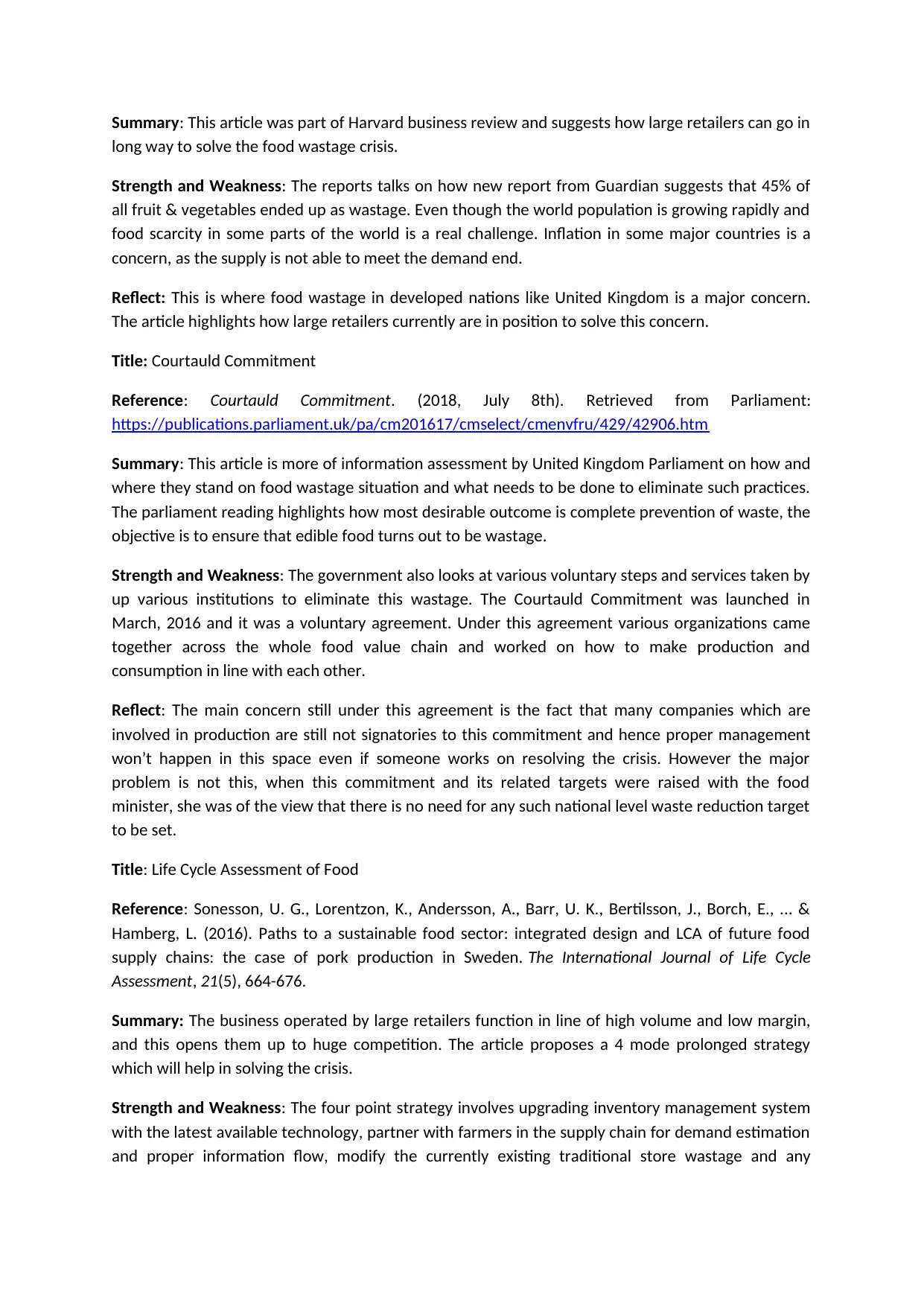
Summary: This article was part of Harvard business review and suggests how large retailers can go in
long way to solve the food wastage crisis.
Strength and Weakness: The reports talks on how new report from Guardian suggests that 45% of
all fruit & vegetables ended up as wastage. Even though the world population is growing rapidly and
food scarcity in some parts of the world is a real challenge. Inflation in some major countries is a
concern, as the supply is not able to meet the demand end.
Reflect: This is where food wastage in developed nations like United Kingdom is a major concern.
The article highlights how large retailers currently are in position to solve this concern.
Title: Courtauld Commitment
Reference: Courtauld Commitment. (2018, July 8th). Retrieved from Parliament:
https://publications.parliament.uk/pa/cm201617/cmselect/cmenvfru/429/42906.htm
Summary: This article is more of information assessment by United Kingdom Parliament on how and
where they stand on food wastage situation and what needs to be done to eliminate such practices.
The parliament reading highlights how most desirable outcome is complete prevention of waste, the
objective is to ensure that edible food turns out to be wastage.
Strength and Weakness: The government also looks at various voluntary steps and services taken by
up various institutions to eliminate this wastage. The Courtauld Commitment was launched in
March, 2016 and it was a voluntary agreement. Under this agreement various organizations came
together across the whole food value chain and worked on how to make production and
consumption in line with each other.
Reflect: The main concern still under this agreement is the fact that many companies which are
involved in production are still not signatories to this commitment and hence proper management
won’t happen in this space even if someone works on resolving the crisis. However the major
problem is not this, when this commitment and its related targets were raised with the food
minister, she was of the view that there is no need for any such national level waste reduction target
to be set.
Title: Life Cycle Assessment of Food
Reference: Sonesson, U. G., Lorentzon, K., Andersson, A., Barr, U. K., Bertilsson, J., Borch, E., ... &
Hamberg, L. (2016). Paths to a sustainable food sector: integrated design and LCA of future food
supply chains: the case of pork production in Sweden. The International Journal of Life Cycle
Assessment, 21(5), 664-676.
Summary: The business operated by large retailers function in line of high volume and low margin,
and this opens them up to huge competition. The article proposes a 4 mode prolonged strategy
which will help in solving the crisis.
Strength and Weakness: The four point strategy involves upgrading inventory management system
with the latest available technology, partner with farmers in the supply chain for demand estimation
and proper information flow, modify the currently existing traditional store wastage and any
long way to solve the food wastage crisis.
Strength and Weakness: The reports talks on how new report from Guardian suggests that 45% of
all fruit & vegetables ended up as wastage. Even though the world population is growing rapidly and
food scarcity in some parts of the world is a real challenge. Inflation in some major countries is a
concern, as the supply is not able to meet the demand end.
Reflect: This is where food wastage in developed nations like United Kingdom is a major concern.
The article highlights how large retailers currently are in position to solve this concern.
Title: Courtauld Commitment
Reference: Courtauld Commitment. (2018, July 8th). Retrieved from Parliament:
https://publications.parliament.uk/pa/cm201617/cmselect/cmenvfru/429/42906.htm
Summary: This article is more of information assessment by United Kingdom Parliament on how and
where they stand on food wastage situation and what needs to be done to eliminate such practices.
The parliament reading highlights how most desirable outcome is complete prevention of waste, the
objective is to ensure that edible food turns out to be wastage.
Strength and Weakness: The government also looks at various voluntary steps and services taken by
up various institutions to eliminate this wastage. The Courtauld Commitment was launched in
March, 2016 and it was a voluntary agreement. Under this agreement various organizations came
together across the whole food value chain and worked on how to make production and
consumption in line with each other.
Reflect: The main concern still under this agreement is the fact that many companies which are
involved in production are still not signatories to this commitment and hence proper management
won’t happen in this space even if someone works on resolving the crisis. However the major
problem is not this, when this commitment and its related targets were raised with the food
minister, she was of the view that there is no need for any such national level waste reduction target
to be set.
Title: Life Cycle Assessment of Food
Reference: Sonesson, U. G., Lorentzon, K., Andersson, A., Barr, U. K., Bertilsson, J., Borch, E., ... &
Hamberg, L. (2016). Paths to a sustainable food sector: integrated design and LCA of future food
supply chains: the case of pork production in Sweden. The International Journal of Life Cycle
Assessment, 21(5), 664-676.
Summary: The business operated by large retailers function in line of high volume and low margin,
and this opens them up to huge competition. The article proposes a 4 mode prolonged strategy
which will help in solving the crisis.
Strength and Weakness: The four point strategy involves upgrading inventory management system
with the latest available technology, partner with farmers in the supply chain for demand estimation
and proper information flow, modify the currently existing traditional store wastage and any
⊘ This is a preview!⊘
Do you want full access?
Subscribe today to unlock all pages.

Trusted by 1+ million students worldwide
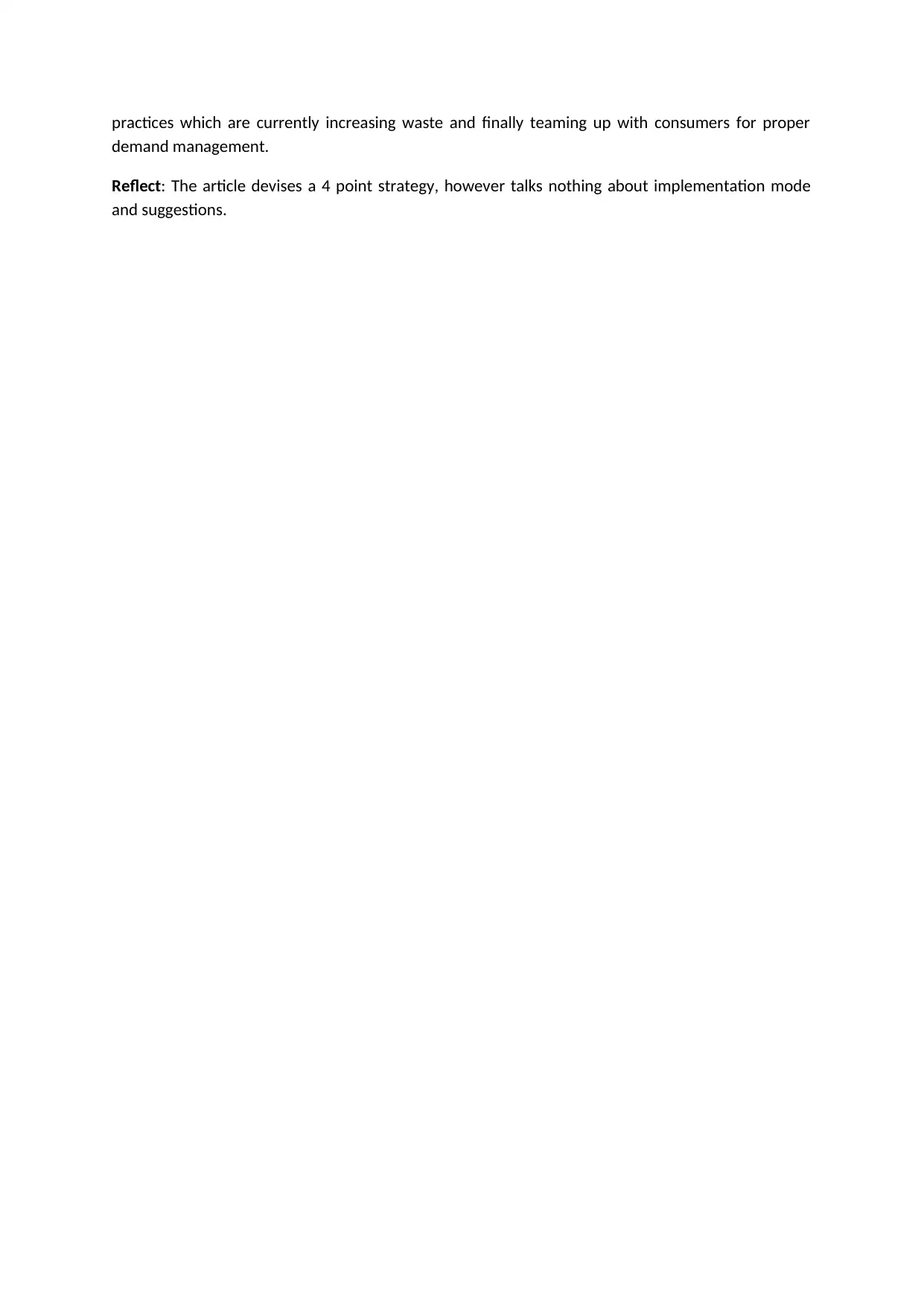
practices which are currently increasing waste and finally teaming up with consumers for proper
demand management.
Reflect: The article devises a 4 point strategy, however talks nothing about implementation mode
and suggestions.
demand management.
Reflect: The article devises a 4 point strategy, however talks nothing about implementation mode
and suggestions.
Paraphrase This Document
Need a fresh take? Get an instant paraphrase of this document with our AI Paraphraser
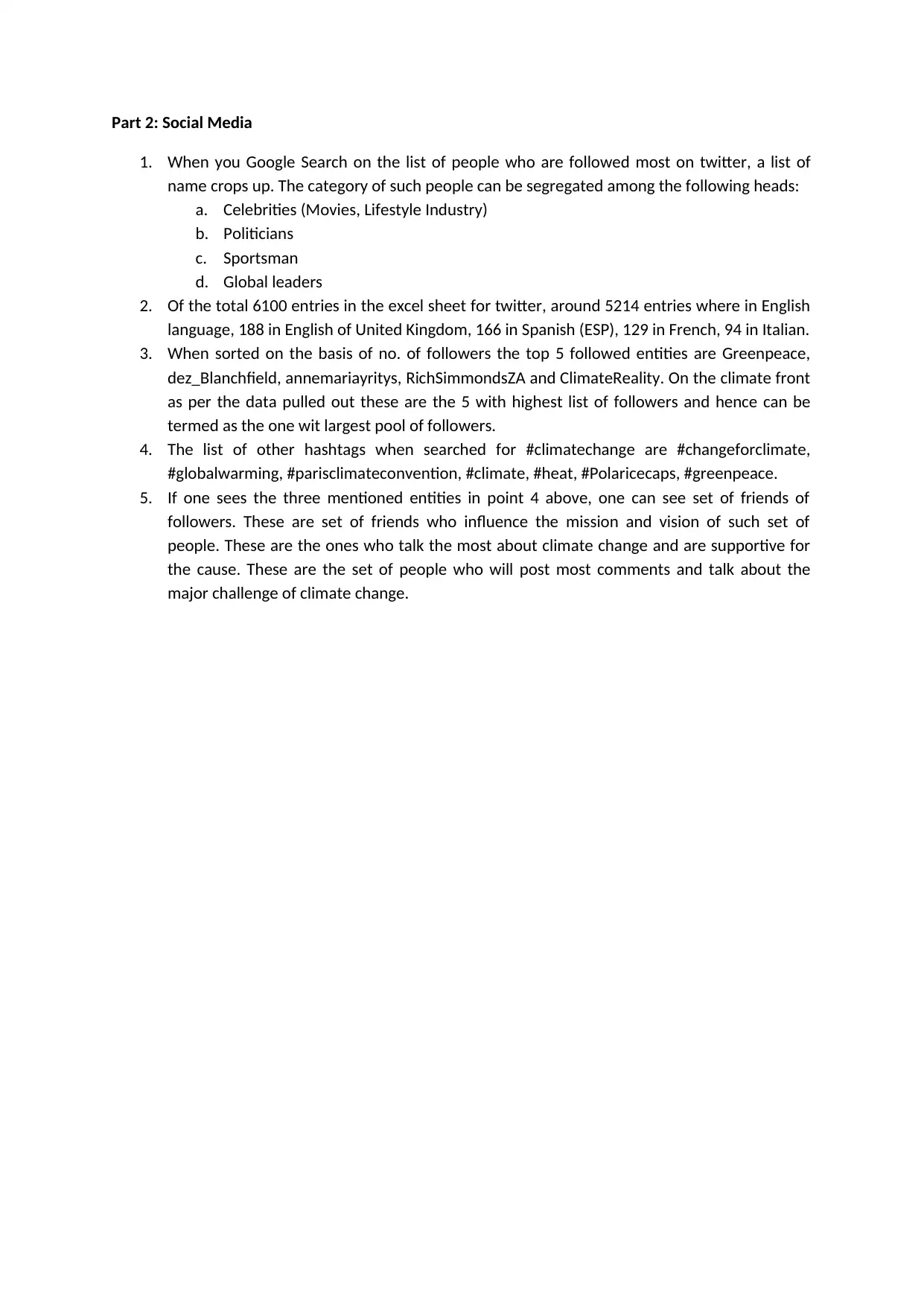
Part 2: Social Media
1. When you Google Search on the list of people who are followed most on twitter, a list of
name crops up. The category of such people can be segregated among the following heads:
a. Celebrities (Movies, Lifestyle Industry)
b. Politicians
c. Sportsman
d. Global leaders
2. Of the total 6100 entries in the excel sheet for twitter, around 5214 entries where in English
language, 188 in English of United Kingdom, 166 in Spanish (ESP), 129 in French, 94 in Italian.
3. When sorted on the basis of no. of followers the top 5 followed entities are Greenpeace,
dez_Blanchfield, annemariayritys, RichSimmondsZA and ClimateReality. On the climate front
as per the data pulled out these are the 5 with highest list of followers and hence can be
termed as the one wit largest pool of followers.
4. The list of other hashtags when searched for #climatechange are #changeforclimate,
#globalwarming, #parisclimateconvention, #climate, #heat, #Polaricecaps, #greenpeace.
5. If one sees the three mentioned entities in point 4 above, one can see set of friends of
followers. These are set of friends who influence the mission and vision of such set of
people. These are the ones who talk the most about climate change and are supportive for
the cause. These are the set of people who will post most comments and talk about the
major challenge of climate change.
1. When you Google Search on the list of people who are followed most on twitter, a list of
name crops up. The category of such people can be segregated among the following heads:
a. Celebrities (Movies, Lifestyle Industry)
b. Politicians
c. Sportsman
d. Global leaders
2. Of the total 6100 entries in the excel sheet for twitter, around 5214 entries where in English
language, 188 in English of United Kingdom, 166 in Spanish (ESP), 129 in French, 94 in Italian.
3. When sorted on the basis of no. of followers the top 5 followed entities are Greenpeace,
dez_Blanchfield, annemariayritys, RichSimmondsZA and ClimateReality. On the climate front
as per the data pulled out these are the 5 with highest list of followers and hence can be
termed as the one wit largest pool of followers.
4. The list of other hashtags when searched for #climatechange are #changeforclimate,
#globalwarming, #parisclimateconvention, #climate, #heat, #Polaricecaps, #greenpeace.
5. If one sees the three mentioned entities in point 4 above, one can see set of friends of
followers. These are set of friends who influence the mission and vision of such set of
people. These are the ones who talk the most about climate change and are supportive for
the cause. These are the set of people who will post most comments and talk about the
major challenge of climate change.
1 out of 5
Your All-in-One AI-Powered Toolkit for Academic Success.
+13062052269
info@desklib.com
Available 24*7 on WhatsApp / Email
![[object Object]](/_next/static/media/star-bottom.7253800d.svg)
Unlock your academic potential
Copyright © 2020–2025 A2Z Services. All Rights Reserved. Developed and managed by ZUCOL.